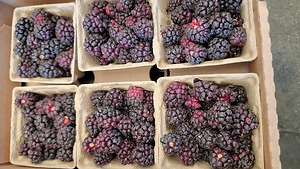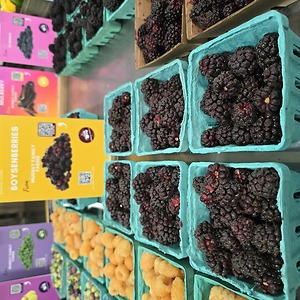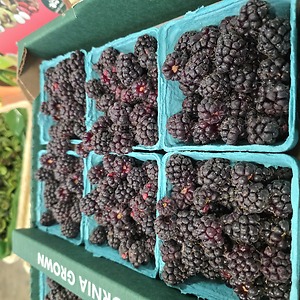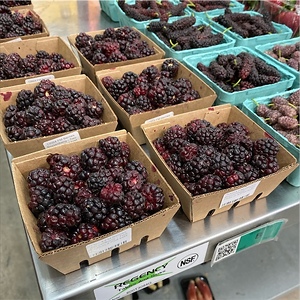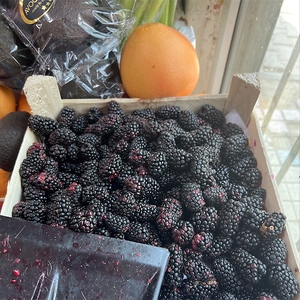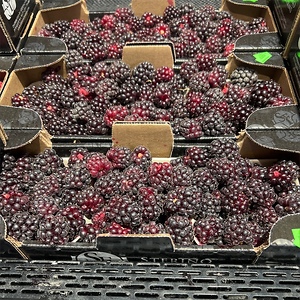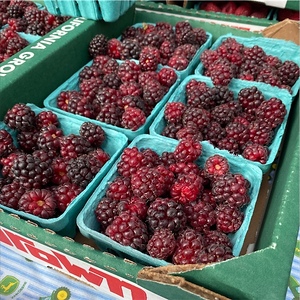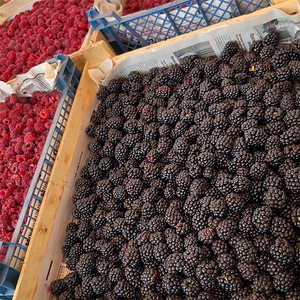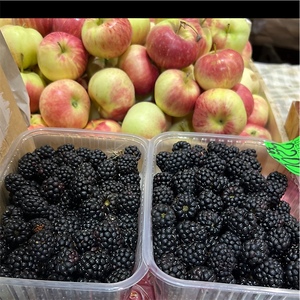


Boysenberries
Estimated Inventory, 12 ct : 0
Description/Taste
Boysenberries are a hybrid berry variety that measures about 2.5 to 3 centimeters long and 2 to 3 centimeters wide, weighing around 8 grams each. Their structure is made up of small druplets tightly clustered around a solid core. Boysenberries have a dark purple-maroon hue that looks almost black with a few ruby red druplets tucked into each berry. These delicate drupelets boast thin, glossy skin with fine yellow hairs that protrude from the fruit. They are embedded with small, round seeds that are firm with a slight crunch. Boysenberries have a sweet, fruity aroma that gets stronger as the fruit ripens. They are juicy and plump with a rich, complex flavor similar to that of blackberries and raspberries. This taste is sweet and floral, with a slight tang and acidity.
Seasons/Availability
Boysenberries are available from late spring to summer.
Current Facts
The botanical name for Boysenberries is Rubus ursinus × Rubus idaeus and they are part of the Rosaceae family, which also includes strawberries, pears, apples, apricots, plums, cherries, and almonds. Boysenberries look almost identical to the standard blackberry but tend to be larger and sweeter. They are a hybrid variety created by cross-pollinating loganberries, raspberries, and blackberries. Boysenberries are a type of dewberry, meaning they often develop on shrubs that grow close to the ground rather than adopting a more vertical growth pattern and ripening in late spring rather than later in the summer. These berries are prized for their culinary uses and were popularized by Knott's Berry Farm, a company celebrated for its jams and preserves.
Nutritional Value
Boysenberries are a good source of vitamins K and C. These vitamins help with bone health, brain function, immune support, collagen production, wound healing, and iron absorption. This berry variety also contains folate and manganese, which may aid in red blood cell production, cell growth, anemia prevention, and metabolism of cholesterol and carbohydrates. Boysenberries are a source of fiber, a nutrient that can benefit cardiovascular and digestive health, stabilize blood sugar levels, decrease bad cholesterol, and promote blood flow. They are rich in anthocyanins, natural antioxidants that help maintain healthy brain cells and protect against oxidative damage that may cause brain aging and Alzheimer’s disease. The polyphenol content in Boysenberry juice may reduce diastolic blood pressure, potentially decreasing the risk of stroke, kidney damage, and hypertension.
Applications
Boysenberries can be eaten fresh, baked, or preserved in cans, jellies, and compotes. They are used interchangeably with blackberries but are sweeter and more fragile to handle. Boysenberries are frequently eaten fresh out of hand or incorporated into smoothies, yogurt parfaits, cocktails, fruit bowls, and salads. They are also a favorite for baked goods like pies, whether featured solo or combined with other berries. The small size and flavorful nature of Boysenberries bode well for frozen treats like ice cream and sorbet. These berries may be reduced into a sweet sauce that compliments savory dishes and hearty proteins. This would include curried chicken, grilled lamb chops, and beef tenderloin. Boysenberries pair well with apricots, peaches, strawberries, citrus, honey, raisins, hazelnuts, cardamom, cinnamon, chocolate, rosemary, juniper berries, mustard seeds, coconuts, mascarpone, brie, poultry, wild game, pork, sherry, and rum. This variety can be stored in the refrigerator for up to a week or frozen on a baking sheet and sealed in a plastic bag for long-term storage.
Ethnic/Cultural Info
Walter Knott, who played a large role in developing and popularizing Boysenberries, is noted for founding Knott's Berry Farm, an amusement park in Buena Park, California. It originally began as a berry market and tea room where Walter and his wife, Cordelia, sold sandwiches, jams, and pies made with berries from their farm. One of the most popular berries was the Boysenberry and another standout dish was their fried chicken, which drew such large crowds that the Knott family eventually expanded the property into a large restaurant where guests would wait up to three hours to dine. The long wait times inspired Walter to create a line that featured a rock garden, historic millstones, waterwheel, and a replica of George Washington’s Mount Vernon fireplace. This evolved into a full-scale replica of a California ghost town and other themed areas, eventually transforming into the roller coaster-filled theme park that remains popular today. Knott's Berry Farm hosts an annual Boysenberry Festival that features a variety of foods, desserts, and wines all showcasing the flavors of this fruit.
Geography/History
The development of Boysenberries started in California during the 1920s and 1930s. A Swedish immigrant named Rudolf Boysen who lived on a ranch in Napa Valley, California was experimenting with raspberry, loganberry, and blackberry plants. The resulting berries were large and succulent but Boysen did not take note of the hybrid when he sold his ranch and moved to Anaheim, California. Luckily, the cuttings from this plant were passed on to another gardener who introduced them to the United States Department of Agriculture. There, a berry specialist named George Darrow recognized the potential of these berries and reached out to a small fruit grower in Buena Park, California named Walter Knott. The two of them eventually got in touch with Rudolf Boysen, who brought them to his old ranch where they experimented with 24 different varieties of bush berries to eventually produce what came to be known as the Boysenberry. These berries grow best in warm climates. As a hybrid breed, they do not grow naturally in the wild but are cultivated for commercial production and grown in home gardens. Boysenberries were commercially released in 1935 and promoted in the United States as a sweeter alternative to blackberries. They were then introduced to New Zealand, which is now the leading producer and exporter of Boysenberries. These fruits are seen as a specialty berry due to their fragile nature, relatively small harvesting window, and short shelf life. They are sold in grocery stores during their peak season but are more commonly sourced from farmers’ markets or home gardens in California, Oregon, and New Zealand.
Recipe Ideas
Recipes that include Boysenberries. One



